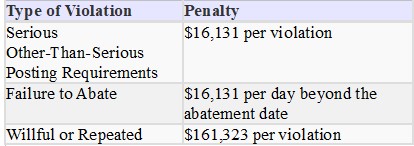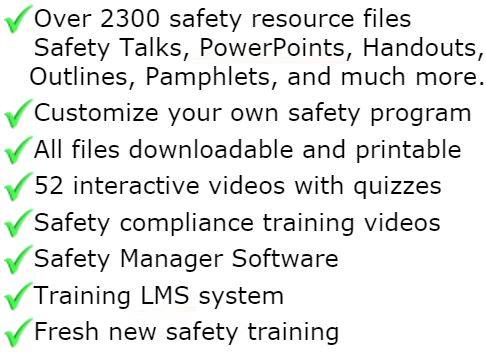
Selling Safety
The absence of accidents does not imply the presence of safety. Whoever first said this hit the target. Having "Safety" is not just a mater of having no accidents. It is also not simply a matter of having good comprehensive written programs. The process of safety involves people, every day, every minute. The first lesson of sales is to understand the difference between "Content and Process".
Content consists of WHAT you want to achieve, or your goal. Content includes written procedures, action lists, step-by-step procedures, training guides or simply verbal instructions. Content defines the scope and end point of a task or project.
Process on the other hand is the group dynamics of HOW a project, procedure or goal is accomplished AND the effect these actions have on individuals and groups for future accomplishment. Process is the single most important factor in affecting success or failure of a task. Understanding and proper use of Process will improve the ability of a group meet goals and exhibit behaviorally specific correct actions such as ALWAYS following Lockout-Tagout procedures every time. Process is that "warm and fuzzy" part of managing people that is often overlooked. Properly used, process can be used to effectively set and enforce standards, convey positive expectations and solve problems. Use every "crisis" as an opportunity to strengthen groups and improve employee performance and involvement.
Having safety means that employees:
• Understand and follow procedure
• Report unsafe conditions
• Encourage others to work safely
• Find, solve and fix the problems in their areas of responsibility
• Suggest improvements in procedures and equipment
• Don't take shortcuts!
Ok, who's responsible for this mess?
Every business has well defined job descriptions for every thing from the company Comptroller to the Custodial Staff. Everybody knows that, if the lowest level employee's job doesn't get done, nobody's happy. So back to the question, who has responsibility for safety? Of course the pat answer is everyone. Nice thought,but let's look at the real picture.
The people who have the most influence on safety are the line supervisors and senior employees. These are the people who work with, direct and observe production employees every minute. They provide the positive or negative pressures that motivate (or de-motivate) workers. If the lowest level supervisors have not bought into the safety programs, and claimed ownership, then not much can or will happen on the safety front.
Department Managers and Project Heads have the most control of safety. Generally they have, or will take, authority to change procedures or redirect resources. Sometimes the most casual comment, such as, "Let's skip that this time" can cause considerable damage to the safety culture in a company. Especially if the change is not communicated and explained properly.
Of course upper management has the responsibility for safety. These are the DJPs (designated jail persons): the ones that go to jail if criminal negligence is found to contribute to a severe injury or death. Yes, many managers have spent some time in the lockup for ignoring workplace hazards. Beyond that, if upper management wants a high degree of concern for safety, with appropriate actions taken to ensure worker safety, they must
• continually communicate this to all management
• provide resources and personnel for safety tasks
• ensure written safety programs meet regulatory requirements and company goals
• discuss safety at staff meetings
• use real safety performance as a part of pay and bonus reviews
Yes, everyone is responsible for safety, but everyone has different roles to play to monitor and improve the safety environment. If safety becomes static, it will fade into the background and again become a "bothersome" burden. Understanding your "customers". Yes, safety professional have customers. As a mater of fact there are three groups of customers that you must serve to effectively manage safety programs. They are management, supervisors and employees. Not only does each of these groups has its own concerns and trigger points for buying into safety, they also have their own "operational language" that you must learn to understand and apply during the sales pitch.
Management needs cost control and measurable results - they speak the language of accounting and process management Supervisor need control of their work areas, defined responsibilities and management support - the speak the language of production & quality control Employees need fair treatment, tools for the tasks and a team environment - they speak the language of effort and acceptance.
Sell a good product. Ninety percent of the "Safety Job" is selling safety. Most managers are not well versed in OSHA safety requirements or even in their own company's safety procedures. Many see safety as simply a list of rules to be followed (unless there is a production crisis - then it's out the window). When you have the opportunity to present anything to your managers, be it a project, memo for their signature, training plan, or simply a list, take the time to prepare a smooth finished copy - never a rough draft or random notes on a scrap of paper. It is the job of the "Safety Person" to complete the research, design and execution plan for every safety task. To do this effectively, look at other similar company documents to get the "flavor and tempo" of methods that have been successful in the past. This philosophy of presenting a clean document is often referred to as "Completed Staff Work". In sales, presentation is everything. Your boss doesn't want scraps.
Sell the Sizzle not the Steak! How do you make people aware of the benefits of your "products & services"? We have seen a great hoopla about behavior based training. Basically, it's a new coat of paint on the old concept of behavior intervention and modification. For as long as the world has existed, human behavior has been a result of a combination of external stimulus as well as internal and associative values. Effective use of these concept can result in improved safety behavior.
Start Day One. The first day on the job is the most important. The new employee brings their own values to your company and this is the time that they are most willing to modify their individual value system to fit in, be accepted and be seen as a positive contributor. Make sure all negative stimulus has been removed from your New Hire Orientation Program. Look at what the new employee actually experiences during that first day. Is there a series of long and boring orientation lectures? Who do they meet and what impact does this have? Do they get to see the big picture and a view of how they will be contributing? Are company values, rules and expectations clearly and simply communicated? Are they introduced to other employees who will also communicate positive values or will they, left on their own, meet the bad apples? Control this new experience the first day and the first week to ensure new employees are properly tuned into your performance expectations.
Using your Safety Committee Members. Make sure your new employees meet a few Safety Committee Members. Let them know the value of these new people and that they are a part of the plan for training new employees, primarily by being seen as someone they can go to when they have questions. Cultivate and train your Safety Committee to be part of the overall plan for ensuring safe behavior by all employees. All employees should see management fully supporting the committee members on the production floor, not just during committee meetings.
Does 100% yield 100%? One of the most effective techniques I have seen used during safety orientation is to tell the new employee that the company is renting their behavior. That is, the company will pay them 100% of the agreed pay and, therefore, the employee has the obligation to adhere to the behaviors required. This includes behavior and attendance at safety meetings and following all safety rules. Believe it or not this turns out to be a novel concept for many new workers. Tell new employees that they will receive 100% of their earned pay. Given that, they will now be more receptive when you tell them that the company should be able to expect 100% compliance with performance expectations. Tell them that you are "renting" their behavior or paying for their service. This won't work on everyone, however, those who are "convinced" will have an impact on those who hang back.
Understanding motivating factors. Communicating positive expectations is only part of the plan. If you expect employees to adopt proper actions and attitudes, the company must overtly and continually make each employee feel accepted, needed and known as an individual who's positive values are appreciated. Get to know the person. Only then can behavior intervention succeed.
Sell, sell sell... and reap the rewards of a smooth running safety program.

GET INSTANT ACCESS
to THE MEMBERS LIBRARY
Safety materials created by safety professionals.
Access to the Safety Manager software.
Wide variety of safety videos and courses.
**Brand New** Safety Training Management System
Pre-Made Safety Materials Ready For Use
Created by experienced safety professionals & risk consultants. Saving you time, money, and risk of injuries.
95% of the work already done.
Below are the maximum penalty amounts, with the annual adjustment for inflation, that may be assessed after Jan. 15, 2024. (See OSHA Memo, Jan. 8, 2024).

**New OSHA HEAT 90 DAY**
>>Download Free HERE<<
**New 2024 OSHA 300 Form**
>>Download Free HERE<<
**Brand New**
Free with full membership subscription
Training LMS System
Ask The Safety Consultant
Safety Equipment Deal Finder

“SafetyInfo.com is the first go-to website for safety professionals and companies to use in establishing a solid safety program"
-Mike McKenzie, Certified Safety & Health Manager (CSHM), McSafety Solutions™
Note: You must have a full subscription to the Safety Library in order to use this material. Any use outside of your organization, for resell, or without an active membership is strictly prohibited and may result in prosecution under copyright infringement laws. Please contact us first, if you would be interested in reselling or using our materials for reproduction.
Inside the Members Library
Topic Index
Accident Prevention
Air Quality
Asbestos
Bloodborne Pathogens
Boilers
Chemical Safety
Compressed Gas
Confined Space
Construction
Construction Worksite
Cranes & Slings
Driver / Fleet Safety
Drug Free Workplace
Electrical
Emergency Management
Engineering Safety
Environmental
Equipment
Ergonomics
Fall Protection
Fire Safety & Prevention
First Aid
Flammable Materials
Forklifts
Hazard Communication
Hazardous Materials
Hearing Protection
Heat Stress
Hot Work
Housekeeping
Job Safety Analysis
Laboratory
Ladders
Lead
Lockout-Tagout
Machinery & Equipment
Material Handling
MSDS (SDS)
Medical & First Aid
Occupational Health
Office Safety
Off the Job Safety
Personal Protection
Process Safety
Record Keeping
Respiratory Protection
Silica Safety
Rules & Policies
Signs & Labels
Slips, Trips & Fall
Training
Terrorism Programs
Tool Safety
Vehicle & Driver
Violence Programs
Welding & Hot Work
Training Videos
Library Index
Training Materials
Videos/Courses
Talks
Articles
PowerPoint
Handouts
Training Overheads
Quizzes
Supervisor Briefs
Management Briefs
Safety Sessions
2 Minute OSHA Safety Talks
Pamphlets
First Aid Training
Supervisor Training
Hazardous Materials
Bomb Threat
Crossword Puzzles
Biological Agents
Forms & Documents
Forms
Checklists
Audit Guides
Inspections Guides
Signs & Labels
Environmental Audit Guides
Recordkeeping - OSHA 300
Sign & Label Maker
Safety Management Resources
Safety Manuals/Written Programs
Ergonomic Programs
Emergency Plans
Process Safety Management
Construction Safety
Occupational Health
Environmental
Topic Sheets
DOT Fleet-Driver
Hazardous Materials
Chemical Safety
Drug Free Workplace
Terrorism Programs
Development Guides
Safety Manager Software
Safety References & Graphics
Technical Safety Information
Posters
Topic & Fact Sheets
Development Information
Job Specific Safety Rules
Terrorism
Calculators
Safety Comic Strips
New Safety Training System
Schedule and train your employees with our materials. Add unlimited amount of employees. Record all progress and issue certificates. For group and individual training sessions.

